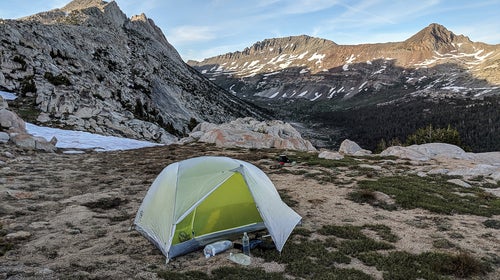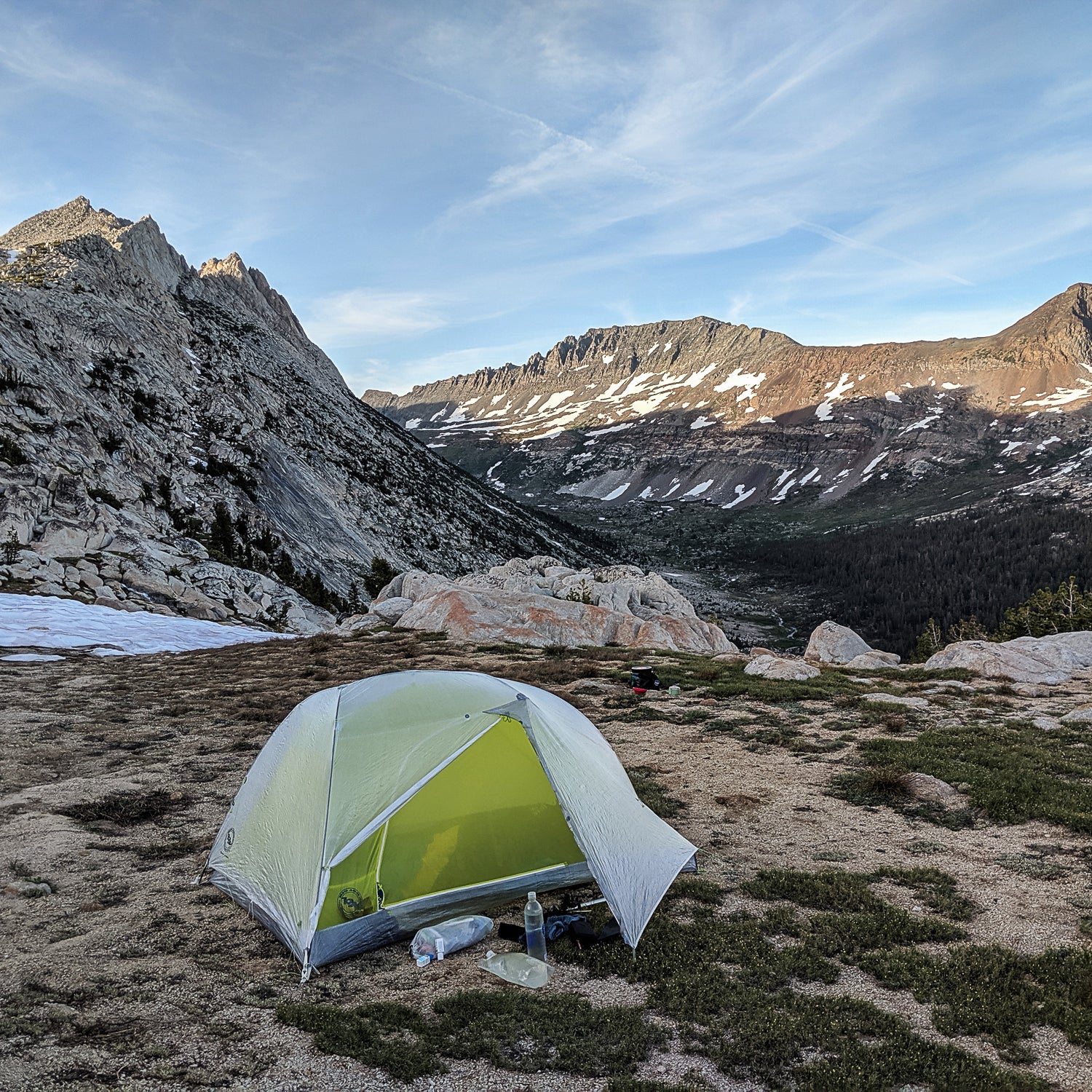Over dinner at the Pump House in Fairbanks, Alaska, with╠řguides Alan Dixon, ÔÇťFlyinÔÇÖÔÇŁ Brian Robinson, and Justin Simoni, I read aloud the disclaimer-filled e-mail about the ╠řthat the companyÔÇÖs╠řPR firm sent me:
The [Tiger Wall Carbon 2] is intended for only the most advanced users. Although itÔÇÖs extremely strong for its weight, itÔÇÖs not indestructible. Special care during setup and extended trips is important, as rough handling, long-term abrasion, exposure to sharp objects, or rocky campsite selection may result in fabric punctures and tears. WeÔÇÖve provided a footprint to improve durability and self-adhesive patches for field repairs. Do not pitch it under pine trees or where it will rub against branches.
I was skeptical about the Tiger Wall Carbon (TWC) and the four other Carbon models when I at Outdoor Retailer last summer. And this e-mail made me even more concerned about using it on two eight-day guided trips in the Brooks Range, which started╠řthe next day. When I asked the table for a second opinion, everyone was╠řin universal agreement: donÔÇÖt do it.
But the forecast looked friendly for the first trip, and Justin had extra room in his tent, so I packed it anyway.
Perhaps to everyoneÔÇÖs surprise, the TWC survived two weeks of benign conditions north of the Arctic Circle. But it failed the following month in Yosemite National Park: on its 22nd╠řnight out, I put a five-inch tear in the fly while setting it up. Further inspection revealed another pencil-eraser-size╠řhole of unknown origin elsewhere on the fly.
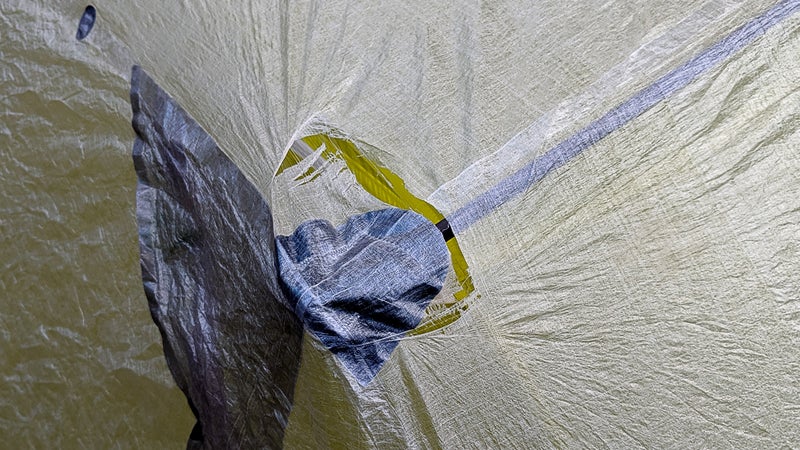
The Big Agnes Tiger Wall Carbon is a guilty pleasure. The and ╠řtents are exorbitantly expensive and unacceptably fragile, but they rival the weight of the lightest full-sided double-wall shelters while being more user-friendly because of their semi-freestanding pitch and often more spacious because of their steep sides and ends.
ItÔÇÖs a novel tent, but IÔÇÖd only recommend it if you match all of the following criteria:
- You can afford to spend $1,000 to $1,200 on just a shelter.
- You baby your gear.
- You will not use it often (and will use it mostly in calm and dry conditions).
- You prioritize the weight of your gear over its performance.
- You donÔÇÖt care to learn about or fuss with the minor eccentricities of trekking pole-supported shelters.╠ř
Overall, the Tiger Wall Carbon is exactly what I feared: stupid light.
I believe that demand exists for semi-freestanding and freestanding tents that are made of Dyneema╠řcomposite fabric (DCF) and that are available from retail giants like REI and brick-and-mortar stores like Neptune Mountaineering. But╠řas itÔÇÖs currently configured, the TWC does not properly address this niche.
Thankfully, the fix is very easy: Big Agnes must replace the 0.34-ounce-per-square-yard╠řDCF fly with heavier-duty 0.5-ounce-per-square-yard fabric (if not a╠ř0.75-ounce-per-square-yard fabric)╠řand replace the 0.51-ounce-per-square-yard floor with a material thatÔÇÖs 0.75 or 1.0 ounce╠řper square yard.
These changes would bump the TWCÔÇÖs weight closer to the Tiger WallÔÇÖs Platinum build, but itÔÇÖd be outrageously durable, waterproof, and storm resistant. Constructed as such, it might only be marginally lighter than the Platinum, but itÔÇÖd be much higher performance.
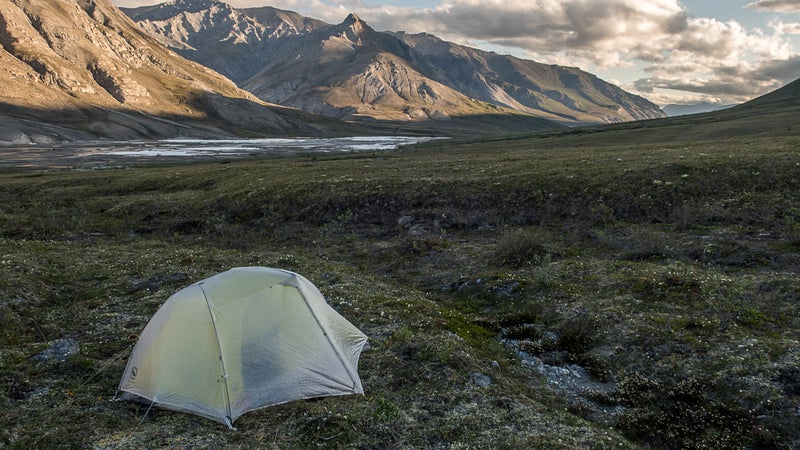
What Should You Buy Instead?
If you are no longer considering the TWC but donÔÇÖt know where else to look, let me offer two suggestions:
1. If you like the Tiger Wall design, consider Big AgnesÔÇÖs╠řUltralight or Platinum trims, which are more durable and much more economical. Then╠řinvest the leftover cash in other equipment that will offset the weight penalty.
- ($400, 2 pounds 3╠řounces)
- ($450, 2 pounds 11 ounces)
- ($550, 1 pound 15 ounces)
- ($600, 1 pound 6╠řounces)
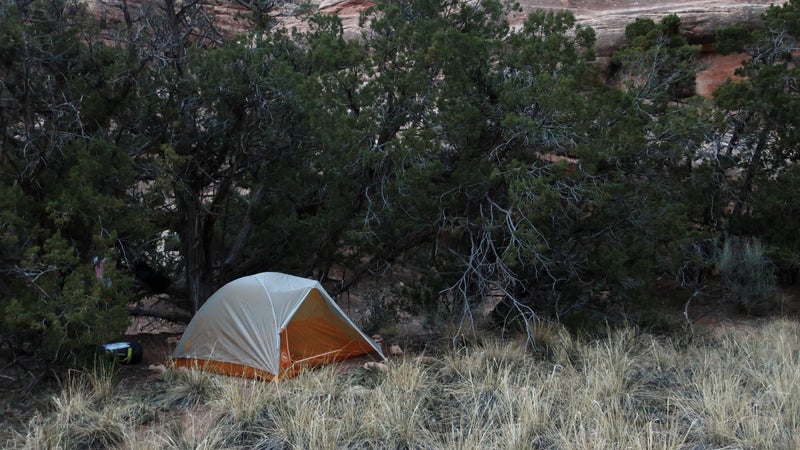
2. If you want a very lightweight full-sided shelter thatÔÇÖs more durable, and youÔÇÖre willing to embrace a fussier pitch, look to the cottage industry.
- ╠řplus╠ř ($430, 1 pound 11 ounces)
- ╠řplus╠ř ($560, 2 pounds 4╠řounces)
- ($535, 1╠řpound)
- ($599, 1 pound 3 ounces)
- ($689, 1 pound 10 ounces)
- ($599, 1 pound 3╠řounces)
- ZPacks Duplex plus╠ř ($125, 1 pound 15 ounces)
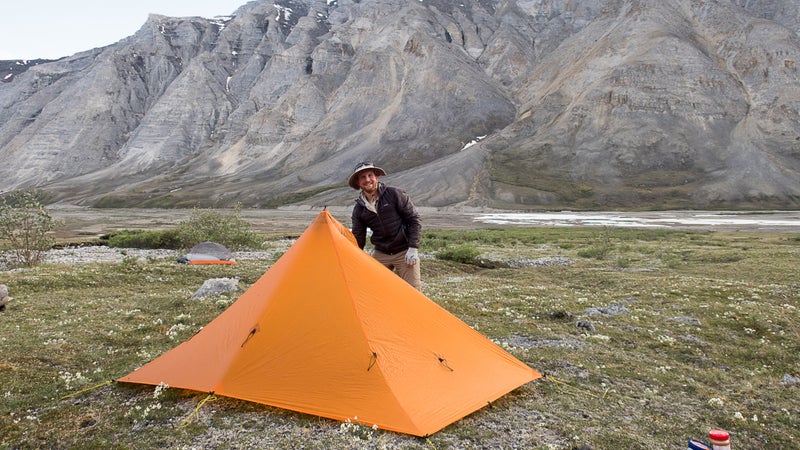
Product Specs
No other semi-freestanding double-wall shelter on the market rivals the weight (or cost) of the Tiger Wall Carbon.╠ř
- MSRP: $1,000
- Weight:╠ř1╠řpound 6╠řounces╠ř
- Capacity: Cramped for two╠řpeople, spacious for a soloist
- Design: Semi-freestanding, two side-entry doors
- Configurations: 1. Fly plus╠řinner /╠ř2. Fly plus╠řinner plus╠řaccessory footprint /╠ř3. Inner on its own /╠ř4. Fly plus╠řaccessory footprint
- Vestibules: Two eight-square-foot vestibules
- Dimensions: Floor: 27 square feet;╠ř52 inches wide, tapers to 42 inches; 86-inches long /╠řPeak height: 39 inches
- Materials: Fly: 0.34-ounce per-square-yard DCF /╠řFloor: 0.51-ounce-per-square-yard DCF /╠řBody: Breathable ripstop nylon /╠řPoles: Easton carbon fiber
Crazy Light
Along with the Tiger Wall 2 Carbon and Tiger Wall 3 Carbon, Big Agnes also released four other Carbon shelters in spring 2019.
- ($800, 1╠řpound)
- ($850, 1╠řpound 2╠řounces)
- ($700, 11 ounces)
- ($500, 8╠řounces)
The only ÔÇťnewÔÇŁ product is the Onyx, which is an overpriced 8.5-square-foot╠řtarp. Otherwise╠řthe Carbon builds are premium editions of existing Big Agnes models. Compared to╠řthe Tiger Wall Platinum, the Carbon editions are 24 to 29 percent lighter; compared to╠řthe Tiger Wall UL, the Carbon editions are 33 to 37 percent lighter.
I have only used the Tiger Wall 2 Carbon, but I think my experience and conclusions generally apply to the other Carbon models, too, given their shared materials and construction. If you didnÔÇÖt meet the aforementioned criteria as a Tiger Wall Carbon customer, the other Carbon shelters wonÔÇÖt suit your needs either.
Basic Design
Two years ago, I reviewed the Tiger Wall UL3, shortly after it was released. Read that review, because IÔÇÖll only provide a summary here.
The good:
- Steep side walls and ends, which optimize interior volume
- Fast and foolproof pitch, even on unfavorable ground
- Two side-entry doors and two vestibules
- Modularity, with three unique configurations (fly plus╠řbody, body only, body plus╠řfootprint)
The imperfect:
- Inherent weight penalty, since it cannot be pitched with trekking poles
- Body is vulnerable to precipitation during setup
- Stock stake loops are nonadjustable, creating difficulties in rocky and rooty campsites
- Realistically, less sleeping space╠řthan advertisedÔÇöthe two-person is a spacious one-person tent, and the three-person is a comfortable two-person tent
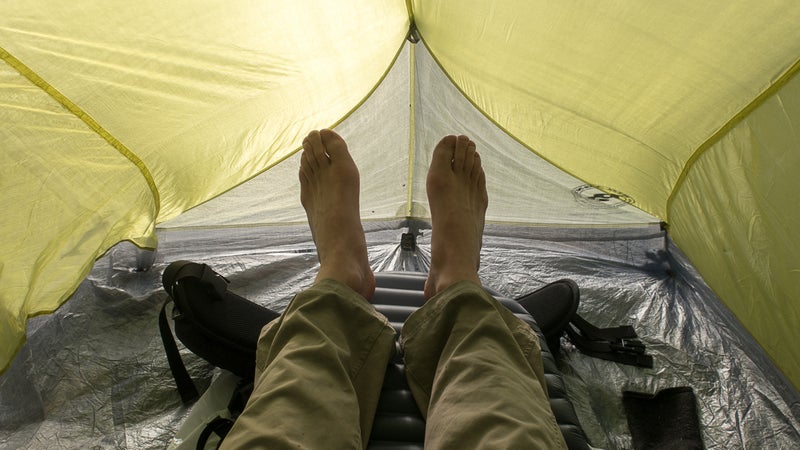
Fragility
To drop weight from its already minimalist Platinum and UL builds, Big Agnes made four substitutions in creating the Carbon trims of the Tiger Wall, Fly Creek, and Scout.
- Fly: 0.34-ounce-per-square-yard╠řDCF, rather than 7-denier or 15-denier silicone-polyurethane-coated nylon
- Floor: 0.51-ounce-per-square-yard╠řDCF, rather than 10-denier or 15-denier silicone-polyurethane-coated nylon
- Poles: Easton carbon fiber, rather than DAC aluminum
- Body: Breathable nylon ripstop, rather than heavier no-see-um mesh
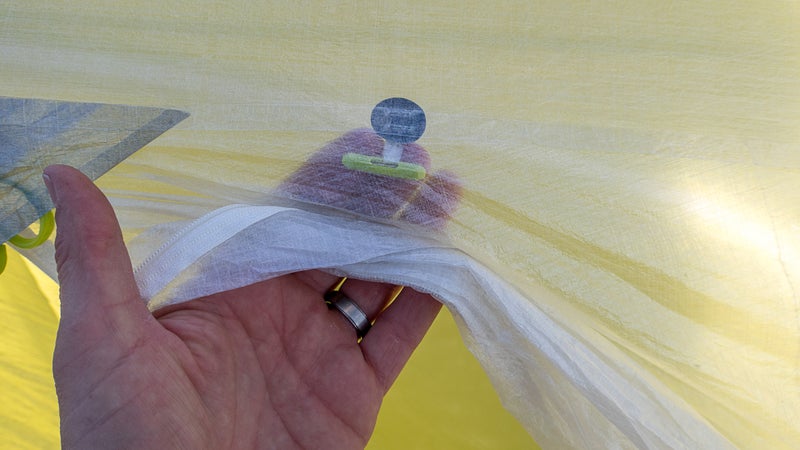
I slept in the Tiger Wall 2 Carbon for 26 nights, split about equally between the Brooks Range and Yosemite. Conditions were ideal for backpacking, less so for gear testing.╠řThe tent was rained on twice, placed on soft ground nearly every night, kept away from dust and mud, and endured light winds only on a few nights.
On its 22nd night, a five-inch tear developed in the fly╠řalong the edge of a reinforced area╠řwhile╠řI was trying to insert the horizontal ceiling pole into its pockets. ItÔÇÖs a tight fit╠řand actually requires bending the poleÔÇöunlike the UL and Platinum fly fabrics, the DCF fly cannot be stretched over it. I knew this was a vulnerable spot, since IÔÇÖd busted both pull loops earlier on.
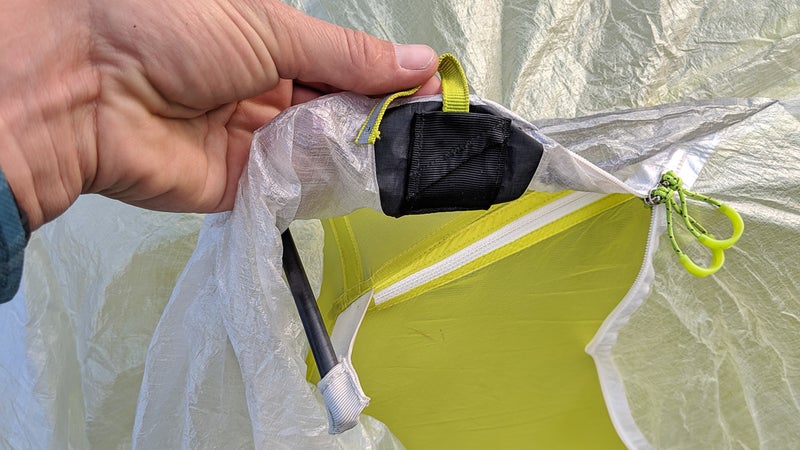
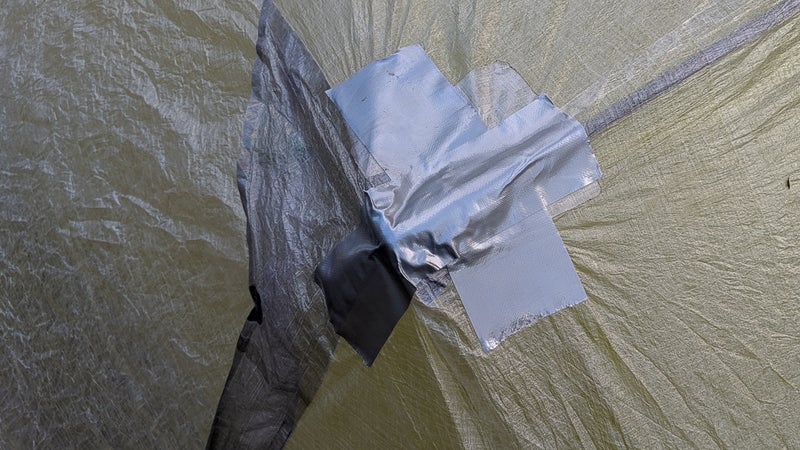
Upon further inspection, I found another hole in the fly. I donÔÇÖt know the exact cause, but abrasion seems most likely.
IÔÇÖve spent thousands of nights in the field, and IÔÇÖve helped clients set up hundreds of different shelters. But IÔÇÖve never seen a shelter fabric rip during setup or due to wind or precipitation╠řor develop an unexplained hole. The 0.34 DCF simply does not seem worthy of anything beyond just-in-case or emergency use. This observation is consistent with the application of DCF by cottage brands, which use 0.51 and 0.75 for the fly╠řand 0.75 and 1.0 for floors.
ItÔÇÖs worth noting that the floor, body, and poles all appear intact.
Repair Recommendations
A repair kit is included with the TWC. The kit includes DCF patches that adhere directly to the fabric.
Big Agnes does not recommend making repairs with duct tape, like I did. It ÔÇťleaves a bad residue and renders the fabric un-repairable,ÔÇŁ wrote╠řthe companyÔÇÖs PR.
For additional tent repair tips, refer to .
Final Thoughts
I want the Carbon builds to succeed: freestanding and semi-freestanding tents made of Dyneema╠řcomposite fabric will be as light and user-friendly as their nylon counterparts╠řbut offer a vastly superior performance. Hopefully, increased use of DCF will also drive down its price.
I applaud Big Agnes for being the first to this market. But IÔÇÖd encourage the brand to rethink its fabric choices╠řand will steer most people away from the Carbon line until a more reliable version is available.
